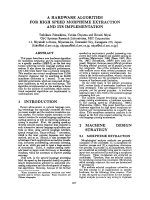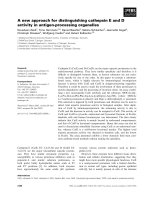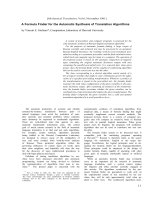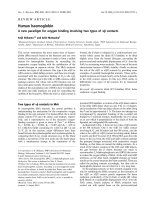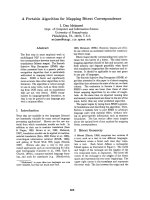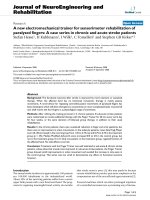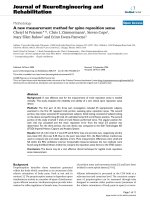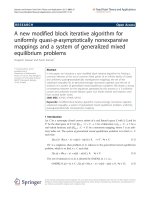Báo cáo hóa học: " A New Algorithm for Joint Range-DOA-Frequency Estimation of Near-Field Sources" docx
Bạn đang xem bản rút gọn của tài liệu. Xem và tải ngay bản đầy đủ của tài liệu tại đây (643.03 KB, 7 trang )
EURASIP Journal on Applied Signal Processing 2004:3, 386–392
c
2004 Hindawi Publishing Corporation
A New Algorithm for Joint Range-DOA-Frequency
Estimation of Near-Field Sources
Jian-Feng Chen
Key Lab for Radar Signal Processing, Xidian University, Xi’an 710071, China
Email:
Xiao-Long Zhu
Key Lab for Radar Signal Processing, Xidian University, Xi’an 710071, China
Department of Automation, Tsinghua University, Beijing 100084, China
Email: xlzhu
Xian-Da Zhang
Department of Automation, Tsinghua University, Beijing 100084, China
Email:
Received 20 December 2002; Revised 29 August 2003; Recommended for Publication by Zhi Ding
This paper studies the joint estimation problem of ranges, DOAs, and frequencies of near-field narrowband sources and pro-
poses a new computationally efficient algorithm, which employs a symmetric uniform linear array, uses eigenvalues together with
the corresponding eigenvectors of two properly designed matrices to estimate signal parameters, and does not require searching
for spectral peak or pairing among parameters. In addition, the proposed algorithm can be applied in arbitrary Gaussian noise
environment since it is based on the fourth-order cumulants, which is verified by extensive computer simulations.
Keywords and phrases: array signal processing, DOA estimate, range estimate, frequency estimate, fourth-order cumulant.
1. INTRODUCTION
In array signal processing, there exist many methods to esti-
matethedirectionsofarrival(DOAs)offar-fieldsourcesim-
pinging on an array of sensors [1], such as MUSIC, ESPRIT,
and so forth. Most of these methods make an assumption
that sources locate relatively far from the array, and thus the
wavefronts from the sources can be regarded as plane waves.
Based on this assumption, each source location can be char-
acterized by a single DOA [1]. When the source is close to the
array, namely, in the near-field case, however, this assump-
tion is no longer valid. The near-field sources must be char-
acterized by spherical wavefronts at the array aperture and
need to be localized both in range and in DOA [2, 3, 4]. The
near-field situation can occur, for example, in sonar, elec-
tronic surveillance, and seismic exploration.
To deal with the joint range-DOA estimation problem
of near-field sources, many approaches have been presented
[2, 3, 4, 5, 6, 7, 8, 9]. The maximum likelihood estima-
tor proposed in [2] has optimal statistical properties, but
it needs multidimensional search and is highly nonlinear.
Huang and Barkat [3]andJeffersetal.[4] extended the
conventional one-dimensional (1D) MUSIC method to the
two-dimensional (2D) ones for range and DOA estimates.
Since 2D MUSIC requires an exhaustive 2D search, their ap-
proaches are computationally inefficient. To avoid multidi-
mensional search, Challa and Shamsunder [7] developed a
total least squares ESPRIT-like algorithm which applies the
fourth-order cumulants to estimate the DOAs and ranges of
near-field sources. Nevertheless, it still requires heavy com-
putations to construct a higher-dimensional cumulant ma-
trix in order to obtain the so-called signal subspace, and
the computational load becomes even intolerable when the
number of sensors is very large. More recently, a weighted
linear prediction method for near-field source localization
was presented in [9], but it needs additional computation to
solve the pairing problem among parameters in the case of
multiple sources.
All the methods above assume that the carrier frequen-
cies are available. If the carrier frequencies are unknown, the
location problem of near-field sources is actually a three-
dimensional (3D) one because three parameters of the DOA,
range, and the associated frequency of each source should
be estimated and paired correctly. This paper proposes a
Joint Estimation for 3D Parameters of Near-Field Sources 387
−N
x
+1 −2 −1
0
12 mN
x
θ
i
r
i
ith near-filed source
Figure 1: Sensor configuration of near-field sources.
computationally efficient algorithm for joint estimation of
the DOA, range, and frequency of each near-field source.
Without constructing the higher-dimensional cumulant ma-
trix, the proposed algorithm applies a symmetric uniform
linear array and uses eigenvalues together with the corre-
sponding eigenvectors of two properly designed matrices to
jointly estimate signal parameters, and it does not require any
spectral peak searching since the parameters are automati-
cally paired.
This paper is organized as follows. Section 2 introduces
the signal model and Section 3 develops a new algorithm. In
Section 4, a series of computer simulations are presented to
demonstrate the effectiveness of the proposed algor ithm, and
finally, conclusions are made in Section 5.
2. PROBLEM FORMUL ATION
Consider the narrowband model for array processing of
near-field sources, as shown in Figure 1. Suppose that there
are K sources of interest with complex baseband representa-
tions s
i
(t), i = 1, , K. Let the band of interest have a center
frequency f
c
and the ith source has a carrier frequency f
c
+ f
i
.
After demodulation to intermediate frequency, the signal due
to the ith source is e
j2πf
i
t
s
i
(t) and the signal received at the
mth antenna is
x
m
(t) =
K
i=1
s
i
(t)e
j2πf
i
t
e
jτ
mi
+ z
m
(t), −N
x
+1 m N
x
,
(1)
in which z
m
(t) is the additive noise, f
i
is the frequency of the
ith source, and τ
mi
is the phase difference in radians between
the ith source signal arriving at sensor m and that at the ref-
erence sensor 0.
Applying the Fresnel approximation, one has the phase
difference τ
mi
as follows [2, 3, 4, 5, 6]:
τ
mi
=
2πr
i
λ
i
1+
m
2
d
2
r
2
i
−
2md sin θ
i
r
i
− 1
≈ γ
i
m + φ
i
m
2
,
(2)
γ
i
=−2π
d
λ
i
sin
θ
i
,(3)
φ
i
= π
d
2
λ
i
r
i
cos
2
θ
i
,(4)
where d is the interelement spacing of the uniform linear ar-
ray, while λ
i
, r
i
,andθ
i
are the wavelength, range, and bearing
of the ith source, respectively.
Sample the received signals at proper rate f = 1/T
s
and
denote
x(k) =
x
−N
x
+1
kT
s
, , x
0
kT
s
, , x
N
x
kT
s
T
,
z(k) =
z
−N
x
+1
kT
s
, , z
0
kT
s
, , z
N
x
kT
s
T
,
s(k) =
s
1
kT
s
e
jω
1
k
, , s
K
kT
s
e
jω
K
k
T
(5)
in which the superscript T denotes transpose and ω
i
=
2πf
i
T
s
, then (1) can be written, in a matrix form, as
x(k) = Bs(k)+z(k), (6)
where B is a 2N
x
×K matrix with the ith column vector given
by
b
i
θ
i
, r
i
=
e
j(−N
x
+1)γ
i
+ j(−N
x
+1)
2
φ
i
, ,
e
j(−γ
i
+φ
i
)
,1,e
j(γ
i
+φ
i
)
, , e
jN
x
γ
i
+ jN
2
x
φ
i
T
.
(7)
The objective of this paper is to deal with the joint esti-
mation problem of the range r
i
, the bearing θ
i
, and the fre-
quency f
i
. For this purpose, the following assumptions are
made:
(A1) the source signals s
1
(t), , s
K
(t) are statistically mutu-
ally independent, non-Gaussian, narrowband station-
ary processes with nonzero kurtoses;
(A2) the sensor noise z
m
(t) is zero-mean (white or colored)
Gaussian signal and independent of the source signals;
(A3) the range parameters of the sources are different from
each other, that is, φ
i
= φ
j
for i = j;
(A4) the array is a uniform linear array with spacing d ≤
λ
i
/4, i = 1, , K;
(A5) the array is a symmetric array with 2N
x
antenna sen-
sors and N
x
>K.
3. A NE W JOINT ESTIMATION ALGORITHM
FOR 3D PARAMETERS
To develop a new joint estimation algor ithm, we begin with
the fourth-order cumulant matrix C
1
, the (m, n)th element
of which is defined by
C
1
(m, n) cum
x
∗
m
(k), x
m+1
(k), x
∗
n+1
(k), x
n
(k)
,
0 m, n N
x
− 1,
(8)
where the superscript ∗ denotes complex conjugate. Sub-
stituting (1) into (8) and using the multilinearity property
of cumulant together with the assumptions (A1) and (A2),
straightforward but slightly tedious manipulations yield [8]
C
1
(m, n) =
K
i=1
c
4s
i
e
j2(m−n)φ
i
(9)
388 EURASIP Journal on Applied Signal Processing
in which c
4s
i
= cum{|s
i
(k)|
4
} denotes the (nonnormalized)
kurtosis of s
i
(k). Let C
4s
= diag[c
4s
1
, , c
4s
K
] be a diagonal
matrix composed of the source kurtoses; we have
C
1
= AC
4s
A
H
, (10)
where the superscript H denotes Hermitian transpose, A =
[a
1
, , a
K
]isanN
x
× K matrix, and
a
i
=
1, e
j2φ
i
, , e
j2(N
x
−1)φ
i
T
, i = 1, , K. (11)
Since al l the source signals are assumed to have nonzero kur-
toses, C
4s
is an invertible diagonal matrix. Additionally, due
to (A3), different sources have different range parameters, A
is of full column rank. Hence, C
1
is an N
x
× N
x
matrix with
rank K, and it is not of full rank for the assumption (A5) that
K<N
x
.
Let {ρ
1
, , ρ
K
} and {v
1
, , v
K
} be the nonzero eigen-
values and the corresponding eigenvectors of C
1
,respectively,
that is, C
1
=
K
i=1
ρ
i
v
i
v
H
i
; we may obtain the pseudoinverse
matrix of C
1
,denotedasC
†
1
,and
C
†
1
=
K
i=1
ρ
−1
i
v
i
v
H
i
. (12)
Due to (10), A has the same column span as V = [v
1
, , v
K
],
and thus the projection of a
i
onto span{v
1
, , v
K
} equals a
i
,
that is, VV
H
A = A. Therefore, it holds that
C
1
C
†
1
A =
K
i=1
ρ
i
v
i
v
H
i
·
K
p=1
ρ
−1
p
v
p
v
H
p
· A
= VV
H
A = A.
(13)
Furthermore, for differ ent sensor lags, we define
C
2
(m, n) cum
x
∗
m−1
(k), x
m
(k), x
∗
−n
(k), x
1−n
(k)
,
C
3
(m, n) cum
x
∗
m
(k +1),x
m+1
(k), x
∗
n+1
(k), x
n
(k)
,
(14)
and similar to (10), we can show that
C
2
= AC
4s
Ω
H
A
H
, (15)
C
3
= AC
4s
Λ
H
A
H
, (16)
where the narrowband assumption, that is, s
i
(k) ≈ s
i
(k +1),
is used [10]and
Ω = diag
e
− j2γ
1
, , e
− j2γ
K
, (17)
Λ = diag
e
jω
1
, , e
jω
K
. (18)
Clearly, both Ω and Λ areoffullrank,soC
2
and C
3
have the
same rank K as C
1
.
In what follows, we apply (10), (15), and (16)tode-
rive a new algorithm for joint estimation of the range, DOA,
and frequency parameters. For convenience of statement,
we denote
C = C
H
2
C
†
1
, (19)
¯
C = C
H
3
C
†
1
. (20)
Postmultiplying both sides of (19)byA, and applying
(15), we obtain
CA = AΩC
4s
A
H
C
†
1
A. (21)
On the other hand, since A is of full column rank, from (10)
we have
C
4s
A
H
=
A
H
A
−1
A
H
C
1
. (22)
Therefore, substituting (22)and(13) into (21) results in
CA = AΩ. (23)
Similarly, it is not difficult to show that
¯
CA = AΛ. (24)
Since from (23)and(24), it can be inferred that the ma-
trices C and
¯
C have the same ranks K and the same eigenvec-
tors, we have the following eigendecompositions:
C =
K
i=1
ϕ
i
u
i
u
H
i
, (25)
¯
C =
K
i
=1
i
u
i
u
H
i
. (26)
Based on (18), (24), and (26), we obtain the estimate of
the frequency, given by
ω
i
= angle
i
, (27)
where angle(·) denotes the phase angle operator.
According to the assumption (A4), that is, d λ
i
/4, (3)
implies −π 2γ
i
π.Hence,wehavefrom(17), (23), and
(25) that angle(ϕ
i
) =−2γ
i
. Substituting this equation into
(3), we get the estimated DOA as
ˆ
θ
i
= sin
−1
λ
i
4πd
· angle
ϕ
i
. (28)
Additionally, (23), (24), (25), and (26) indicate that A
has the same column span as U = [u
1
, , u
K
], that is,
span{a
1
, , a
K
}=span{u
1
, , u
K
}, therefore, a
i
can be es-
timated by the associated eigenvector u
i
. Mimicking [11],
one may obtain
ˆ
φ
i
by minimizing a least squares cost f unc-
tion
N
x
−1
m=1
(mφ
i
− angle(u
i
(m +1)/u
i
(1)))
2
given by
ˆ
φ
i
=
12
N
x
(N
x
− 1)
2N
x
− 1
N
x
−1
m=1
m angle
u
i
(m +1)
u
i
(1)
. (29)
Joint Estimation for 3D Parameters of Near-Field Sources 389
Once
ˆ
θ
i
and
ˆ
φ
i
are available, the range r
i
can be estimated
using (4), yielding
ˆ
r
i
= π
d
2
λ
i
ˆ
φ
i
cos
2
ˆ
θ
i
. (30)
For the proposed algorithm, we point out that, since the
eigenvectors (associated with the K nonzero eigenvalues) of
C are easily matched with those of
¯
C by contrasting the two
sets of eigenvectors [12], while they can be both considered
as estimates of the K column vectors of A,itiseasytodeter-
mine the correct pairing of the range, DOA, and frequency
parameters of each source.
Finally, it is helpful to compare the proposed algorithm
to the ESPRIT-like one [7]. Both methods require construct-
ing cumulant matrices, but they estimate the DOA and range
parameters in different ways. Besides the eigenvalues, the
eigenvectors are also used in this paper. More importantly,
the proposed algorithm employs ably the narrowband as-
sumption of the sources to estimate the frequencies, and it
need not construct the higher-dimensional cumulant matrix,
which takes advantages over the one presented in [7]. Con-
cerning the computational complexity, we ignore the same
computational load of the two methods that is compara-
tively small (e.g., calculations involved in (19)and(20)in
this paper and similar operations in the ESPRIT-like one)
and consider the major part, namely, multiplications in-
volved in calculating the cumulant matrices and in per-
forming the eigendecompositions, our algorithm requires
27(2N
x
+1)
2
M +(4/3)N
3
x
, while the ESPRIT-like one requires
36(2N
x
+1)
2
M+(4/3)(3N
x
)
3
,whereM is the number of snap-
shots and N
x
is the number of sensor. Clearly, the proposed
algorithm is computationally more efficient, and i n general
cases, M N
x
, it has the computational load, at most, 75
percent of the ESPRIT-like one [7].
4. SIMULATION RESULTS
To verify the effectiveness of the proposed algorithm, we con-
sider a uniform linear array consisting of N = 14 sensors
with element spacing d = min (λ
i
/4). Two equi-power sta-
tistically independent sources impinge on the linear array,
and the received signals are polluted by zero-mean additive
Gaussian noises. We assume that the two sources are nar-
rowband (bandwidth = 25 kHz) amplitude modulated sig-
nals with the center frequency equal to 2 MHz and 4 MHz,
respectively. The data are sampled at a rate of 20 MHz. The
performance is measured by the estimated root mean square
error (RMSE):
E
RMSE
=
1
N
e
N
e
i=1
ˆ
α
i
− α
true
2
(31)
in which
ˆ
α
i
denotes estimate of the true parameter α
true
ob-
tained in the ith run, while N
e
is the total number of Monte-
Carlo runs.
Input SNR (dB)
0 5 10 15 20 25
RMSE (degree)
10
−2
10
−1
10
0
10
1
The proposed method, source 1
The proposed method, source 2
The ESPRIT-like method, source 1
The ESPRIT-like method, source 2
Figure 2: The RMSE of the estimated DOA over 500 Monte Carlo
runs versus the input SNR; 14 sensors and 1000 snapshots are used
and the two equi-power sources approach the array from 38
◦
and
20
◦
,respectively.
For comparison, we execute the ESPRIT-like algorithm
proposed in [7] at the same time and simulate two different
cases.
In the first experiment, the first source locates at θ
1
= 38
◦
with range r
1
= 1.3λ
1
and the other locates at θ
2
= 20
◦
with
range r
2
= 0.65λ
2
.TheRMSEofrangeparameterisnor-
malized (divided) by the signal wavelength λ.Thenumberof
snapshots is set to 1000 and the signal-to-noise ratio (SNR)
varies from 0 dB to 25 dB. The additive Gaussian noise may
be white or colored. Since the results are alike, we simply con-
sider the colored Gaussian noise as below:
z(k) = e(k)+0.9e(k − 1) + 0.385e(k − 2) (32)
in which e(k) is white Gaussian noise whose variance is ad-
justed so that σ
2
z
= 1.
The averaged performances over 500 Monte Carlo runs
for range, DOA, and frequency estimates of both sources are
shown in Figures 2, 3,and4,respectively,fromwhichwecan
see the following facts:
(1) the proposed algorithm has a slightly worse estimation
accuracy of DOA than the ESPRIT-like one at low SNR
regions;
(2) although for each algorithm, the RMSE of the range
estimate of source 2 (the source closer to the array) is
much lower than that of source 1, our algorithm per-
forms clearly better than the ESPRIT-like one;
(3) the proposed algorithm has satisfactory frequency es-
timation accuracy even at low SNR regions. (By con-
trast, the ESPRIT-like one assumes that the carrier fre-
quency is known a priori.)
390 EURASIP Journal on Applied Signal Processing
Input SNR (dB)
0 5 10 15 20 25
RMSE (λ)
10
−4
10
−3
10
−2
10
−1
10
0
The proposed method, source 1
The proposed method, source 2
The ESPRIT-like method, source 1
The ESPRIT-like method, source 2
Figure 3: The RMSE of the estimated range over 500 Monte-Carlo
runs versus the input SNR; 14 sensors and 1000 snapshots are used,
and the two equi-power sources approach the array from 38
◦
and
20
◦
,respectively.
Input SNR (dB)
0 5 10 15 20 25
RMSE (rad)
10
−4
10
−3
10
−2
10
−1
The proposed method, source 1
The proposed method, source 2
Figure 4: The RMSE of the estimated frequency over 500 Monte
Carlo runs versus the input SNR; 14 s ensors and 1000 snapshots are
used and the two equi-power sources approach the array from 38
◦
and 20
◦
,respectively.
In the second experiment, we use the same parameters in
the first experiment, except that the SNR is fixed at 15dB and
that the number of snapshots varies from 100 to 1900. The
Number of snapshots
200 400 600 800 1000 1200 1400 1600 1800
RMSE (degree)
10
−2
10
−1
10
0
The proposed method, source 1
The proposed method, source 2
The ESPRIT-like method, source 1
The ESPRIT-like method, source 2
Figure 5: The RMSE of the estimated frequency over 500 Monte
Carlo runs versus the number of snapshots; 14 sensors are used and
the SNR is fixed at 15dB. Two equi-power sources approach the ar-
ray from 38
◦
and 20
◦
,respectively.
Number of snapshots
200 400 600 800 1000 1200 1400 1600 1800
RMSE (λ)
10
−4
10
−3
10
−2
10
−1
10
0
The proposed method, source 1
The proposed method, source 2
The ESPRIT-like method, source 1
The ESPRIT-like method, source 2
Figure 6: The RMSE of the estimated frequency over 500 Monte
Carlo runs versus the number of snapshots; 14 sensors are used and
the SNR is fixed at 15dB. Two equi-power sources approach the ar-
ray from 38
◦
and 20
◦
,respectively.
results are shown in Figures 5, 6,and7. Obviously, similar
conclusions can be made. As compared with the ESPRIT-like
one [7], the proposed algorithm has greatly improved range
Joint Estimation for 3D Parameters of Near-Field Sources 391
Number of snapshots
200 400 600 800 1000 1200 1400 1600 1800
RMSE (rad)
10
−4
10
−3
10
−2
The proposed method, source 1
The proposed method, source 2
Figure 7: The RMSE of the estimated frequency over 500 Monte
Carlo runs versus the number of snapshots; 14 sensors are used and
the SNR is fixed at 15dB. Two equi-power sources approach the ar-
ray from 38
◦
and 20
◦
,respectively.
estimation accuracy since it makes full use of the information
of the matrices C and
¯
C.
5. CONCLUSION
Based on a symmetric uniform linear array, a computation-
ally efficient algorithm based on the fourth-order cumu-
lants is presented in this paper for joint estimation of the
range, DOA, and frequency parameters of multiple near-
field sources. The 3D parameters are estimated by the eigen-
values and the corresponding eigenvectors of two properly
constructed matrices, and hence no additional algorithm is
needed to pair among parameters. Extensive computer sim-
ulations show that the proposed algorithm performs more
satisfactorily than the existing one [7].
ACKNOWLEDGMENTS
The authors would like to thank the four anonymous review-
ers and the associate editor Z. Ding for their valuable com-
ments and suggestions on the original manuscript. This work
was supported by the National Natural Science Foundation
of China (Grant no. 60375004).
REFERENCES
[1] H. Krim and M. Viberg, “Two decades of array signal process-
ing research: the parametric approach,” IEEE Signal Processing
Magazine, vol. 13, no. 4, pp. 67–94, 1996.
[2] A. L. Swindlehurst and T. Kailath, “Passive direction-of-
arrival and range estimation for near-field sources,” in 4th
Annual ASSP Workshop on Spectrum Estimation and Model-
ing, pp. 123–128, Minneapolis, Minn, USA, August 1988.
[3] Y D. Huang and M. Barkat, “Near-field multiple source lo-
calization by passive sensor array,” IEEE Trans. Antennas and
Propagation, vol. 39, no. 7, pp. 968–975, 1991.
[4] R. Jeffers, K. L. Bell, and H. L. Van Trees, “Broadband pas-
sive range estimation using MUSIC,” in Proc. IEEE Int. Conf.
Acoustics, Speech, Signal Processing, vol. 3, pp. 2921–2924, May
2002.
[5] D. Starer and A. Nehorai, “Path-following algorithm for pas-
sive localization of near-field sources,” in 5th ASSP Work-
shop on Spectrum Estimation and Modeling, pp. 322–326,
Rochester, NY, USA, October 1990.
[6] J H. Lee, C M. Lee, and K K. Lee, “A modified path-
following algorithm using a known algebraic path,” IEEE
Trans. Signal Processing, vol. 47, no. 5, pp. 1407–1409, 1999.
[7] R. N. Challa and S. Shamsunder, “Higher-order subspace
based algorithm for passive localization of near-field sources,”
in Proc. 29th Asilomar Conf. Signals System Computer,pp.
777–781, Pacific Grove, Calif, USA, October 1995.
[8] N. Yuen and B. Friedlander, “Performance analysis of higher-
order ESPRIT for localization of near-field sources,” IEEE
Trans. Signal Processing, vol. 46, no. 3, pp. 709–719, 1998.
[9] E. Grosicki and K. Abed-Meraim, “A weighted linear predic-
tion method for near-field source localization,” in Proc. IEEE
Int. Conf. Acoustics, Speech, Signal Processing, vol. 3, pp. 2957–
2960, May 2002.
[10] A.N.Lemma,A.J.vanderVeen,andEdF.Deprettere,“Anal-
ysis of ESPRIT based joint angle-frequency estimation,” in
Proc. IEEE Int. Conf. Acoustics, Speech, Signal Processing, vol. 5,
pp. 3053–3056, Istanbul, Turkey, June 2000.
[11] G. Liao, H. C. So, and P. C. Ching, “Joint time delay and
frequency estimation of multiple sinusoids,” in Proc. IEEE
Int. Conf. Acoustics, Speech, Signal Processing, vol. 5, pp. 3121–
3124, Salt Lake City, Utah, USA, May 2001.
[12] T H.LiuandJ.M.Mendel,“Azimuthandelevationdirection
finding using arbitrary array geometries,” IEEE Trans. Signal
Processing, vol. 46, no. 7, pp. 2061–2065, 1998.
Jian-Feng Chen was born in Lingbi, An-
hui province, China, in 1973. He received
his B.S. degree in radio electronics from the
Northeast Normal University, Jilin, China,
in 1996, and his M.S. degree in signal and
information processing from the 54th Re-
search Institute of China Electronics Tech-
nology Group Corporation, Shijiazhuang,
China, in 1999. Currently, he is working to-
ward his Ph.D. degree in the Key Laboratory
for Radar Signal Processing at Xidian University, Xi’an, China. His
research interests include array signal processing, smart antennas,
and communication signal processing.
Xiao-Long Zhu received his B.S. degree in
measurement and control engineering and
instrument in 1998, and his Ph.D. degree in
signal and information processing in 2003,
respectively, both from Xidian University,
Xi’an, China. Currently, he is with the De-
partment of Automation, Tsinghua Univer-
sity, Beijing, China, as a Postdoctoral Fel-
low. His current research interests include
bind signal processing, subspace tracking,
and their applications in communications.
392 EURASIP Journal on Applied Signal Processing
Xian-Da Zhang received his B.S. degree in
radar engineering from Xidian University,
Xi’an, China, in 1969, his M.S. degree in
instrument engineering from Harbin Insti-
tute of Technology, Harbin, China, in 1982,
and his Ph.D. degree in electrical engineer-
ing from Tohoku University, Sendai, Japan,
in 1987. From August 1990 to August 1991,
he was a Postdoctoral Fellow in the Depart-
ment of Electrical and Computer Engineer-
ing, University of California at San Diego. From 1992, he has been
with the Department of Automation, Tsinghua University, Beijing,
China, as a Professor. From April 1999 to March 2002, he was with
the Key Laboratory for Radar Signal Processing, Xidian Univer-
sity, Xi’an, China, as a Specially Appointed Professor awarded by
the Ministry of Education of China and the Cheung Kong Schol-
ars Programme. His current research interests are signal processing
with applications in radar and communications and intelligent sig-
nal processing. He has published 25 papers in several IEEE Transac-
tions, and is the author of six books (all in Chinese). He holds four
patents. Dr. Zhang is a Senior Member in IEEE and a Reviewer for
several IEEE Transactions and Journals.
